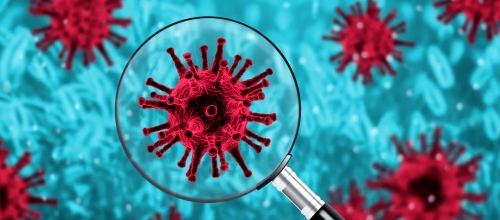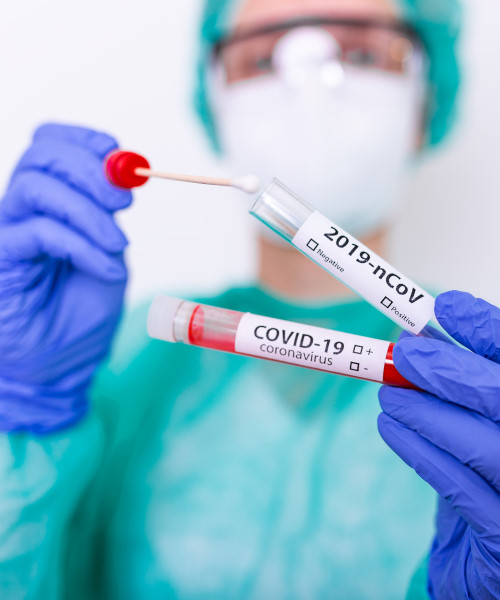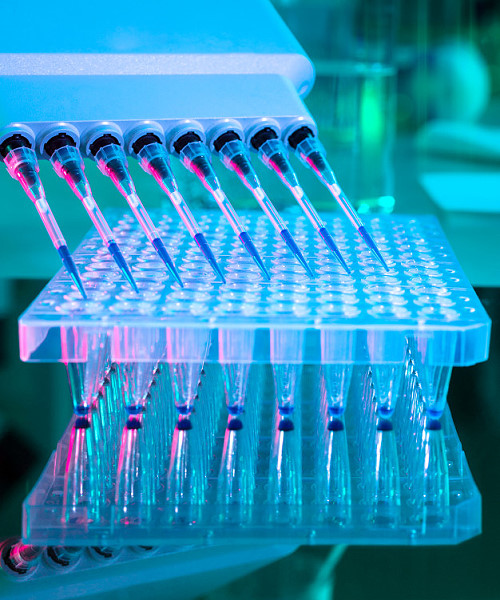Diagnostic Tests COVID-19
Diagnostic Tests COVID-19

Diagnostic Tests COVID-19
● Rapid Antigen Detection Tests (Swabbing)
● Rapid Antibody Detection Tests (IgM/IgG)
● Detection tests by the ELISA method of neutralizing antibodies in SARS-CoV-2
● Rapid Nucleic Acid Detection Tests (PCR-Fluorescent Probe)

Rapid Antigen Detection Tests (Swabbing)
This type of test is intended for the qualitative detection of proteins against SARS-CoV-2, called antigens, by taking nasopharyngeal or throat samples. The test is based on the specific antigen-antibody reaction and immunoassay technology.
During the test, the N protein of the sample (virus protein) combines with the N protein monoclonal antibody SARS-CoV-2 N (which is present in the test) to form a conjugate. The formation of this conjugate indicates that the test is positive. If the conjugate is not present, the test is considered negative.
Features:
● Non-invasive.
● Simple to use.
● No devices required.
● Rapid, get result in 15 minutes.
● High accuracy.
● Practice, mass screening.
● Inexpensive.

Rapid Antibody Detection Tests (IgM/IgG)
These tests are used for the qualitative detection of the content of antibodies against SARS-CoV-2 in serum, plasma or whole blood samples. Mainly two antibodies are detected: immunoglobulin M (IgM) that indicates a recent infection since it is the first warning signal that our body generates against pathogens, so it can be used for the early diagnosis of infection; immunoglobulin G (IgG) that appears after IgM, generating a stronger and more specific reaction against the virus.
The tests are based on the antigen-antibody reaction detected by chromatographic immunoassay. When IgM antibodies against SARS-CoV-2 are present in the sample, they bind to the SARS-CoV-2 recombinant protein (present in the test), generating a positive reaction for the IgM antibody. In the same way it happens with IgG. If this antibody is detected in the sample taken, it binds to the SARS-CoV-2 recombinant protein (present in the test) producing a positive reaction for IgG. Positive reactions are visualized with a red band appearing in M test area and G test area. The absence of red bands in these areas indicates a negative result.
It is important to note that these tests do NOT detect the virus, but the antibodies that are responsible for fighting it, therefore, it can be said that antibody tests measure our body’s response to Covid-19.
Features:
● Efficient, results in 10-15 min.
● Accurate.
● Simple.
● Affordable.

Detection tests by the ELISA method of neutralizing antibodies in SARS-CoV-2
This type of test is based on the specific recognition of neutralizing antibodies to the SARS-CoV-2 virus, using a laboratory technique called ELISA (Enzyme-Linked Immunosorbent Assay).
The ELISA technique for these tests in particular consists of placing a sample of blood serum (plasma) from the patient in a well that contains a solution of antigens of the SARS-CoV-2 virus, these antigens are the RBD (Receptor Binding Domain of glycoprotein S, known as the “peak” of the coronavirus), they appear inside the body only if there has been a direct binding of antibody-glycoprotein S, which means the patient’s immune system has fought against COVID-19. Then, the antibodies present in the patient’s plasma will neutralize the SARS-CoV-2 antigens. After the antibody-antigen binding is formed, a solution containing a secondary antibody bound to a chemical group is added that generates a specific color when bound to the antibody-antigen complex and another when bound only to the antigen. The generated color allows quantifying the amount of anti-RBD antibodies developed in the patient or the absence of them.
By having knowledge of the exact antibody value that the patient has, it can be determined if their antibody load is efficient or inefficient against COVID-19, this is an important fact that is beneficial for epidemiological studies of the SARS-CoV-2 virus.
Application areas:
● Evaluation of the risk of infection for a multidisciplinary health team.
● Determination of the need for the vaccine against COVID-19.
● Selection of plasma donors for the treatment of critically ill patients suffering from COVID-19.
● Quantification of antibodies in patients vaccinated against COVID-19.
● Verification of positive results for SARS-CoV-2 antibodies.

Rapid Nucleic Acid Detection Tests (PCR-Fluorescent Probe)
This type of test consists of the detection of nucleic acid of the SARS-CoV-2 from samples collected by throat swabs (oropharynx, part of the throat just behind the mouth) of people suspected with COVID-19. Qualified healthcare personnel collect samples.
As these are rapid detection tests the results are obtained in real time, thereby providing information on the presence or absence of SARS-CoV-2 RNA in the patient.
The real-time reverse transcription polymerase chain reaction (RT-PCR) is the most sensitive technique for nucleic acid detection, combining amplification and detection in a single step with a signal from fluorescence intensity of the product for each cycle of PCR. The equipment that allows this technique to be carried out are thermal cyclers coupled to a fluorometer (a unit capable of detecting fluorescent signals).
Features:
● Easy to use.
● A big number of samples can be handled.
● It allows to obtain results from a big number of patients in short time.
● Suitable for detection during the COVID-19 pandemic.
● High sensitivity.
Our Team
Convallis ullamcorper aliquet ultrices orci cum vestibulum lobortis erat.


